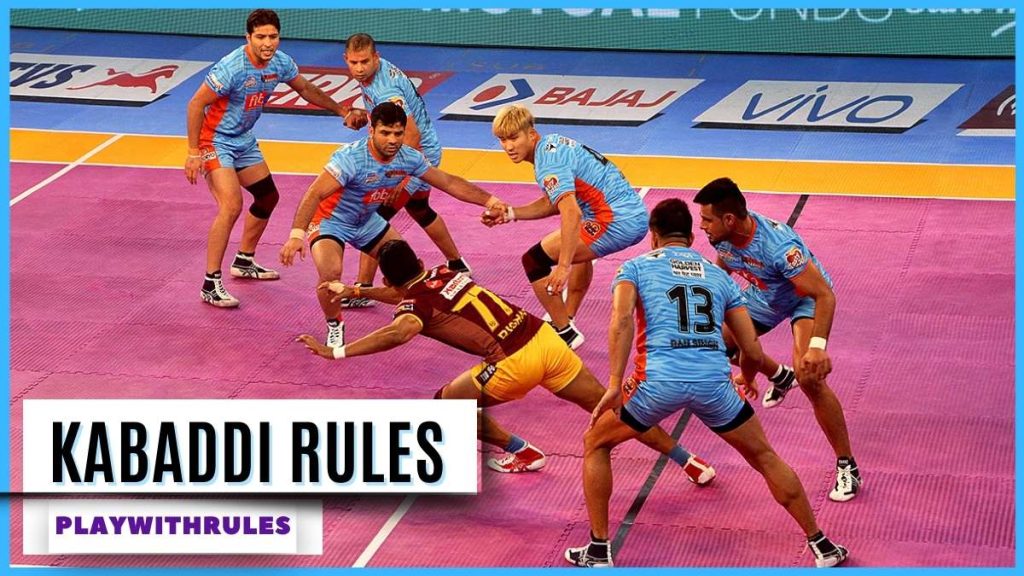Kabaddi Rules: With its origins deep in India, Kabaddi evolved as a favorite sport for enthusiasts. Its popularity has recently reached new heights across the world. Sprinkled with strategy, Kabaddi is an explosive game that appeals to players and viewers alike.
How did a game like Kabaddi become a global sensation? Well, the credit goes to the nature of the game. Kabaddi is not a sport that you watch quietly as you sip your morning coffee. It is a sport whose fast-paced nature will keep you on the edge of your seat as you watch every movement with bated breath. Want to learn more about Kabaddi Game? Then, let’s get right to it!
Table of Contents
How To Play Kabaddi Game?
In general, Kabaddi game resembles a more complicated and nuanced game of cat-and-mouse where two teams try to tag each other to score points. However, scoring is more challenging than it sounds. There are Kabaddi rules for scoring points that are layered with conditions. Not to mention, the Kabaddi court plays a pivotal role in determining the outcome of the game. Each team gets a turn to send out a player who forays into the opposition’s side of the court to tag one or more players and return to the home side, thereby scoring a point for the team.
Objective
The objective of the Kabaddi game is for each team to try to outscore their opponents before time runs out. Each team takes turns defending points and attacking (scoring points). But what are the rules of Kabaddi game? Let’s find out.
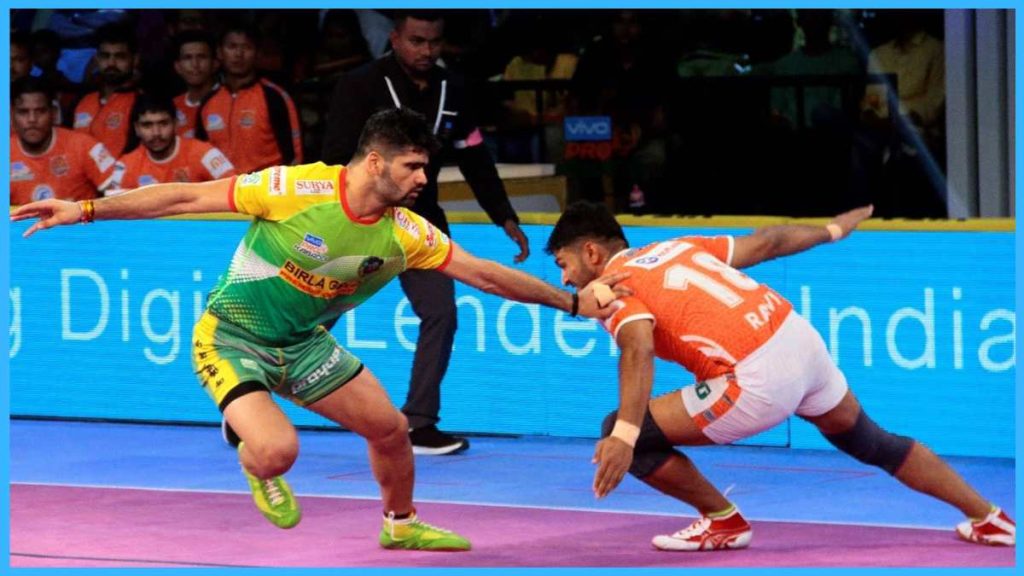
Kabaddi Rules
Kabaddi is a high-energy, high-octane game in which players must have great stamina, endurance, agility, and strength. Although the mechanics are relatively simple, the rules and regulations can confuse outsiders. In this section of the article, we will explain the Kabaddi Rules and break them down so that everyone can better understand the game:
- A coin toss is conducted at the beginning of each game.
- The team that wins the toss decides whether to raid first or choose the side of the court.
- In the second half of the game, the teams change sides.
- Teams alternate in taking turns to raid. A team that raids in one round will defend in the following one, and the defending team will attack.
- The team that did not raid first in the first half of the game will raid first in the second half.
- The number of players on either side will remain the same when starting the game in the second half.
- Only active players can be substituted after the first half. ‘Out’ players cannot be substituted.
1. Raider Rules
Before learning about the raider Kabaddi Rules, let’s first discuss what a raider is. A raider is a player from the attacking team who is sent to the opposition’s half to score points. Here are the rules of kabaddi pertaining to the Raiders:
- They have to hold their breath for one play, i.e., until they reach the opponent’s court and return to their own.
- To signify that they are doing it in one breath, they have to chant ‘Kabaddi’ for the entire duration of that single play.
- A pause or failure to chant ‘Kabaddi’ at any point during the raider’s attempt to score points will result in a foul. The raider will have to head back to their team’s half, and the opponent team (defenders) will be awarded a point.
- The raider’s first goal is to reach the baulk line. Failing to do so will result in him being out, and he cannot participate in the next part of the game.
- The second goal of the raider is to touch and tag as many opponent players as possible and to make it back to the midline before he is tackled and stopped. He gets the point if the raider makes it back to the midline.
- The raider can touch and tag the opponent players using their hands, toe touch, and kicks. They must also try to escape the tackles and touch the midline with their hands to earn a point.
- The raider gets one point for each opponent player that they tag and makes it back to the midline while continuously chanting ‘kabaddi.’
- If a raider puts one foot inside the Bonus Line (explained later) and gets back to the midline without being stopped, he will score one point.
2. Defender Rules Of Kabaddi
Defenders are players who are to be tagged by the attacking players. Their job is to prevent the raider from tagging them and making it back to the midline of the court. Here are the Kabaddi rules pertaining to defenders in a Kabaddi match:
- If a defender is touched, they will be out of the court and cannot participate in the next round of the game.
- A defender can tackle a raider after being touched using maneuvers like ankle hold (leg grabbing), back golf (grabbing from behind), front tackle (grabbing from the front), and pushing out (forcing the player out of the court playing area). Only the raider’s limbs and torso can be grabbed or tackled. Other areas of the body are off-limits.
- If the defenders tackle and stop the raider from reaching the midline after tagging them, then the raider is out, and the defending team gets one point.
- Once a raid is complete (successful or unsuccessful), the defending team must send out a raider from their side within 5 seconds. If they fail to do so, the team will lose a point.
3. Reviving Players
Once players are out, they have to retreat to the sitting block, wait for their team to score a point, and revive them. Reviving a player means getting them back into the field of play. If a team attacks and scores a point or defends and scores a point, they get to revive and bring back one team player.
4. Duration
Although it depends from promotion to promotion, a regular Kabaddi match consists of two 20-minute halves for a total gameplay duration of 40 minutes. There is a 5-minute break between each half. However, for international games, everything remains the same except the total duration of the gameplay is 45 minutes. Each round is 15 minutes for junior competitions, meaning the total match time is 35 minutes.
5. Court Area Rules of Kabaddi
The rules of Kabaddi game extend beyond the players the way one can score points. There are also regulations for the court, with special rules for specific areas. Let’s find out more:
Lobby
This is a particular area that runs along the sides of the court. It only becomes active and can be considered part of the court once a defender is touched/tagged. It is an extended area of play that facilitates a raider or defender escaping the midline or stopping the retreat, respectively.
Bonus Line
The bonus line is behind the respective teams’ home zones. It is usually denoted by a red line behind the baulk line on either side of the court. However, scoring using the Bonus Line is more challenging because it is deep into the opposing team’s end. Also, the bonus line only becomes active when 6 or 7 players are on the court (defending team).
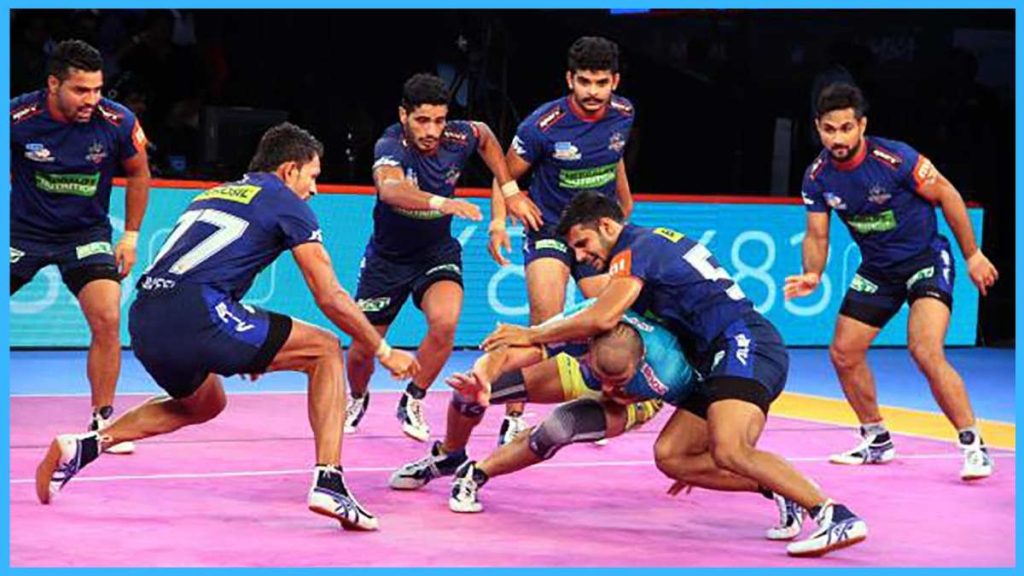
Important Terms (Additional Scoring Techniques)
Now that you are well-versed in the game let’s learn more about Kabaddi’s terminology. You need to be aware of specific terms before you can start playing a competitive game of Kabaddi. In fact, understanding these terms is essential to fully understanding and fully appreciating the dynamic game of Kabaddi. Here are some of these essential terms:
Super Tackle
As ‘super’ as it sounds, this tackle is a great way to rack up extra points. A ‘super tackle’ is when only 2 or 3 defenders are active on the Kabaddi court, and they manage to stop a raider. A super tackle earns the defending team two points: one for eliminating the raider and one as a bonus point for tackling the raider with only 2 or 3 defenders.
Do Or Die Raid
A ‘Do Or Die Raid’ is the third raid when a raiding team (attacking team) fails to score in two previous, consecutive raiding rounds. In other words, if a team fails to score points in two raid rounds, the third raid round is referred to as a ‘Do Or Die Raid.’ The raider is eliminated if the attacking team fails to score any point, even in the third round.
Pursuit
‘Pursuit’ is when a defender pursues a retreating raider to score a point off of him. This is feasible when the raiding player is slow to retreat to their own team’s corner, and the defending team is close enough to tag a player and make it back to the midline before the other team realizes. It is a form of quick play.
All Out
If a raider is able to get all the defending players out in a single raid, it is called an ‘All Out.’ Rare as it is, an ‘All-Out’ benefits the raiding team as it is awarded one point per player eliminated, along with two additional points. All ‘Out’ players are revived after an All-Out.
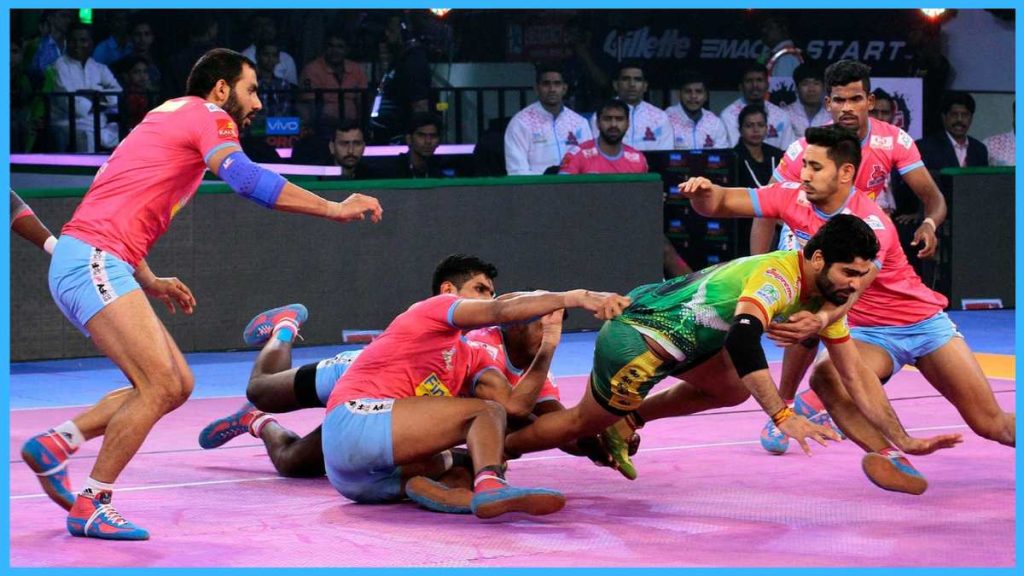
Scoring
Scoring is relatively simple in Kabaddi game – you score a point for each opponent player that you get ‘out.’ However, there are other ways of scoring points as well. For example, you can earn Bonus Points for your team through maneuvers like Super Tackle, All Out, and more.
Winning
The team with the most points at the end of the stipulated time/duration of the game wins. If both scores are tied at the end of the game, then the match is deemed a draw.
Tips & Strategies
At a glance, it might seem like Kabaddi is anybody’s game. However, in court, you realize how difficult scoring even a single point can be. Kabaddi is a game that combines physicality and strategy astonishingly well, making it one of the most physically and mentally demanding games. But, if you want some quick tips to help you get better at this game, then you came to the right place. Here are some valuable tips and strategies that you can work with:
- Feinting – Master the art of feinting, as it will help you create more space on the court. Feinting or faking will urge the opponents to lunge out more or retreat more, opening up the court for you or changing the pace of the play in your favor.
- Toe Touch – Another technique that you should strive to master is the toe touch. The leg is the longest limb of your body, and using it effectively will let you tag your opponent while allowing you to maintain considerable distance between you and your opponents.
- Improve Mat Awareness—Work on increasing your mat awareness. Practice drills geared towards improving that area because they allow you to be conscious of the lines on the mat and the distance between you and the midline. Being aware of the court, the lines, and the different areas will allow you to strategize better.
- Breath Control—Kabaddi is a game of exertion. It requires physical fitness and a lot of breath control. Practice breathing techniques and exercises to hold your breath for longer. Also, make sure you practice chanting ‘Kabaddi’ and moving so that it gets etched in your subconscious.
- Advanced Tackling—Practice advanced tackling and defending techniques like chain tackles and holds. This will allow you to coordinate with your teammates when defending and increase your point-scoring ability multiplefold.
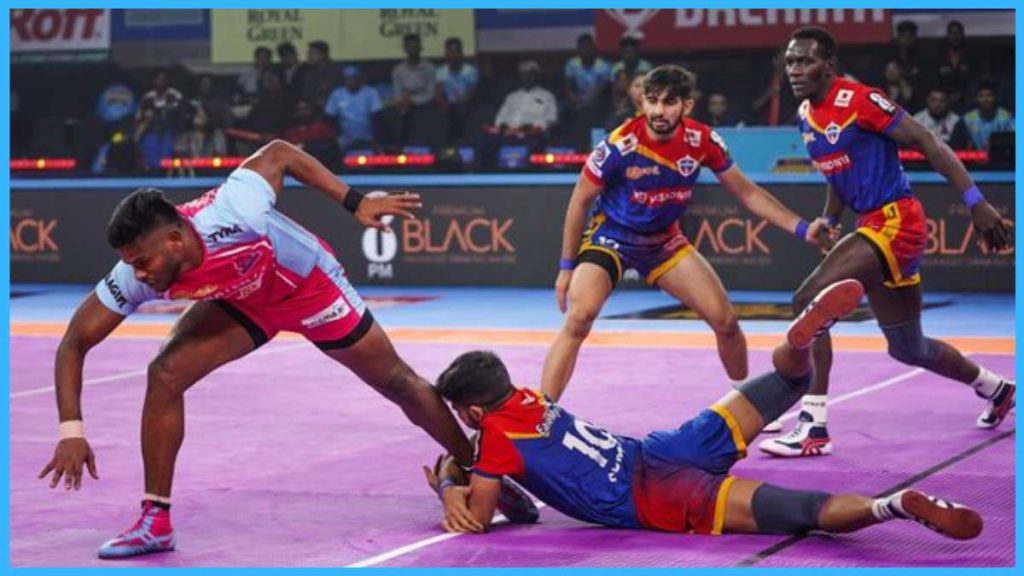
Court, Players, & Equipment
Players: Each team in Kabaddi game must have 12 players on their side. However, only seven players can start the game for each team. The rest of the five players are all substitutes.
Court: A typical Kabaddi court measures 13 m X 10 m and is separated by a white line running through the middle. This is the midline. The bonus line lies behind the baulk line on either side of the court. The lobby is the extended play area on either side of the court.
Equipment: Unlike other sports, Kabaddi game does not require fancy equipment. Some players prefer wearing shoes, while others prefer to play barefoot.
FAQs
Is Kabaddi an Olympic sport?
Although it was demonstrated at the Olympics, Kabaddi is yet to be an Olympic sport.
Can there be more or less than seven players on the Kabaddi court?
No, unless you are not playing professionally. However, you can substitute if you want to.
Can you tackle your opponents in Kabaddi game?
Yes, you can. However, there are specific regulations about tackling in Kabaddi. For example, you cannot grab your opponent’s hair or clothing to tackle them. Limbs and the torso are fair game.
What happens if I tag someone and enter the lobby?
If you tag one or more opponents and enter the Lobby area past the midline, you score a point. However, if you enter the lobby but fail to touch the midline, you are eliminated, and the opponent scores a point.
Did You Know?
- Maharashtra and Tamil Nadu are credited with the invention and practice of Kabaddi.
- It is believed that Kabaddi originated in India about 4,000 years ago.
- Kabaddi is the national game of many Indian states, including Punjab, Bihar, Maharashtra, and Telangana.
- Kabaddi game has a slightly different interpretation in Bangladesh and is called Hadudu. In Maharashtra, it is called Hututu; in the Maldives, it is called Baibalaa.
- Kabaddi is a popular sport in foreign countries as well. It is pretty popular in Iran and Nepal.
- The International Kabaddi Federation is the official governing body of Kabaddi across the wo
Kabaddi game is a testament to India’s rich heritage and the dynamic nature of sports that don’t have to be complicated. Its ever-growing popularity has been long overdue. Now, thanks to the incredible Kabaddi players who have graced this game and the advent of the Pro Kabaddi League, this spectacular sport has captivated audiences worldwide.
Think you know enough? Get, set, and Roll! Keep coming back to Play With Rules for more such impactful learning on sports around the world.

